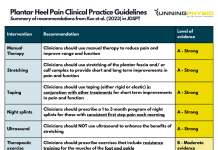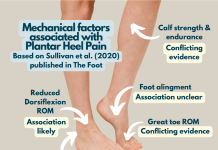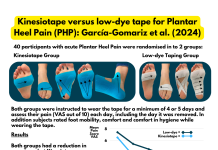Our articles are not designed to replace medical advice. If you have an injury we recommend seeing a qualified health professional. For more information see our Terms and Conditions.
Plantar Heel Pain (PHP) is probably the most common foot condition I see in runners. Although they’ll usually call it Plantar Fasciitis (or something close to that!). It’s a pathology that can be difficult to treat and lead to long-term symptoms. One study (Hansen et al. 2018) found that 46% of people with PHP still had symptoms 10 years after the onset!
I’m always on the lookout for research and resources to share with you so when I came across this study (Osborne et al. 2023) I thought it was a great opportunity to explore exercise options in PHP. In this email, we’ll talk a little about this research and then 3 progressive exercise programmes, each for a specific target population with heel pain.
Osborne et al. (2023) is an open-access Delphi study. They recruited 18 experts in heel pain and completed 3 rounds of surveys to reach a consensus on strengthening exercises for PHP.
Patients with PHP come from a variety of different populations so 1 programme wouldn’t be sufficient to meet the differing needs. As a result, they created 3 separate programmes for the target populations; young athletic adults, overweight middle-aged adults and older adults. Stages, reps, sets and load were considered too.
We created a visual for each of the 3 programmes for you. I’ve modified the programme names to something a little more patient-friendly:
- Young athletic adults ➡️ Athletic Programme
- Overweight middle-aged adults ➡️ Intermediate Programme
- Older adults ➡️ Improver Programme



I’m teaming up with foot and ankle specialist and all-round legend Liz Bayley to bring you these programmes with photos of each exercise. I’ll let you know as soon as they’re ready. In the meantime, be sure to follow Liz on Instagram via @Liz_Bayley_Physio.
Pros and cons
I like Delphi studies, they’re a good way to showcase expert knowledge but that’s also their limitation – it’s essentially expert opinion and not proof of efficacy.
That’s something to consider with these specific programmes, they haven’t yet been tested in these target populations. That’s likely to be the next step in the research.
Some individual components have been tested. For example, the calf raise with toes dorsiflexed was found to be effective in Rathleff et al. (2014). As with any intervention we need to use our reasoning and judgement and test them on an individual basis.
There are a couple of exercises we’d probably replace, toe spreading and the short foot exercise. Many people (including me) can’t spread their toes so really struggle with that exercise. The reps and duration for the single-leg standing in the older adults programme might benefit from a tweak too! I think 2 minutes is a long time to balance single leg so I would usually suggest shorter holds (e.g. 10 seconds) and more reps (e.g. 10) plus support if needed.
Replacement exercises
If a patient had reduced range in the ankle or great toe then I’d would usually address that as this can influence the windlass mechanism and foot function. For example, I might include some plantar fascial stretches:

Image source: DiGiovanni et al. (2003)
If balance is impaired I would want to include more control and proprioception exercises. Some patients try to offload the plantar fascia by loading more through the lateral foot so we may want to focus on addressing this and restoring confidence in using the foot normally again.
The exercises within the programmes from this study are fairly foot focussed, some patients will have strength needs in other areas in the kinetic chain which we can assess and help them address. Some patients may want to focus on other goals such as cardiovascular fitness or weight loss. Non-impact exercises like cycling, swimming and rowing are usually well tolerated in PHP.
There are also some options that might surprise you… barefoot walking and barefoot running!
This was a surprise to me as these are often aggravating factors for heel pain. Perhaps like many things, the difference between medicine and poison is the dose!
We’ll be covering more exercise options for PHP in upcoming blogs so keep a look out for those!










